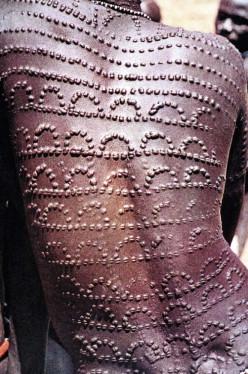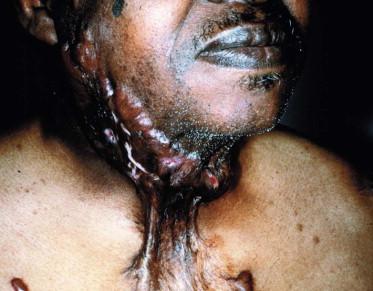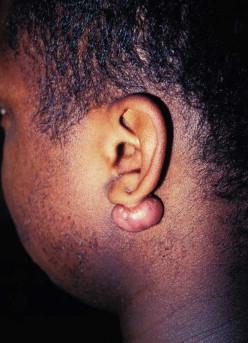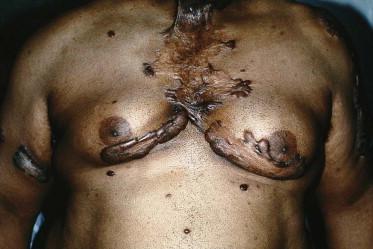Physical Address
304 North Cardinal St.
Dorchester Center, MA 02124
Keloids are a hyperproliferative response of connective tissue to trauma, appearing most commonly in areas of high skin tension.
Their etiology and pathogenesis are poorly understood, though multiple endocrine factors may play a part, and there is evidence of genetic predisposition.
In the early stages, diagnosis may be difficult, but mature keloids are easily distinguishable from hypertrophic scars.
Keloids often itch, burn, and cause pain, and in certain locations may cause dysfunction because of restriction of movement.
Treatment depends on the morphology and location of the keloid, and techniques include corticosteroid therapy, surgical excision, laser surgery, radiation therapy (RT), compression therapy, application of silicon products, interferon injection, imiquimod application, cryotherapy, and 5-fluorouracil therapy.
A combination of pre- and post-surgical adjunctive care is the ideal management approach in most cases.
Prevention is a major goal in patients with a history of keloids and surgical procedures should be planned with prevention in mind.
Descriptions of keloids can be found in the Smith Papyrus dating back to 3000 bc . Jean Alibert was the first to use the term “cheloide” in 1806, derived from the Greek chele (crab's claw), to describe the morphology of keloids. Despite ancient recognition, we have made remarkably little progress towards understanding keloid physiopathology with preventive and management implications. Avoidance of trauma resulting from voluntary and elective cosmetic procedures (i.e., to adorn, augment, or improve) may prevent keloids. Aggressive prevention of keloids after accidental trauma and necessary surgery is also within our abilities. However, some putative causative factors of keloid formation are non-modifiable: ethnicity, skin pigmentation, age, gender, and genetic make-up.
We review what is known about keloid epidemiology and pathogenesis in an effort to gain insight into the development of rational treatment and prevention plans for these unsightly lesions.
The reported incidence of keloid formation is highly variable and population dependent. It ranges from a low of 0.09% in England, to a high of 16% in Zaire. Such variation is explained by numerous variables including race and degree of skin pigmentation. In predominately black and Hispanic populations, incidences between 4.5% and 16% have been reported. Darkly-pigmented individuals develop keloids 2–19 times more frequently than non-Hispanic whites. Ethnicity, regardless of pigment intensity, is also a factor. In Aruba, more children of the lighter-skinned Polynesian population form keloids than those of African descent. Although non-Hispanic whites develop keloids less frequently, those who do can be very fair skinned. These patients are often among the most difficult to treat.
Keloids can occur at any age; however, their development is relatively less common in the prepubescent and the elderly. Aging fibroblasts may be less capable of collagen overproduction. Keloid regression after the menopause has been reported. Small gender differences that have been reported in the literature are likely the result of cultural trends and reporting bias. Multiple ear piercings are far more common in women than men, as are the resulting keloids. Additionally, women may more readily seek medical attention for cosmetic improvement.
The plethora of existing theories regarding the etiology of keloids is indicative of our lack of understanding of the condition. The factors that are most consistent are skin trauma occurring in individuals with a genetic predisposition for keloids. Increased wound tension at closure and infection and further trauma that can result in additional wound tension may also play a role ( Box 43.1 ).
Trauma
Skin tension
Infection – primary infection and wound infections
Endocrine – estrogens and melanocyte-stimulating hormone
Genetic
Although “spontaneous” keloids arising in non-injured skin have been suggested, trauma is probably a requisite for keloid formation. The severity of the trauma may be sufficiently insignificant as to go unnoticed by the patient. Minor abrasions and burns, insect bites, varicella, herpes zoster, vaccinations, and tattoos can result in significant keloids. Acne lesions of the anterior chest and deltoid areas often morph imperceptibly into keloids. Isotretinoin treatment in these patients can prevent additional keloids even when the acne lesions are not readily identifiable. Deep and significant surgical wounds are often less likely to keloid than are the minor wounds described above. It is not uncommon to see the development of keloids at the drain site next to the large surgical wounds that failed to keloid.
However, trauma only serves as a potential precipitating etiologic factor. Intra-patient variation is marked; most patients experiencing the same trauma do not develop keloids. Thus, a second factor, perhaps genetic, would be necessary to act as an additional trigger for the development of keloids following trauma. However, there is marked variation even within a given patient. Areas prone to trauma such as the hands and feet rarely keloid. This could be explained by evidence of a phenotypic difference between fibroblasts taken from earlobe keloids and palmar skin. Less easy to explain are the common observations that acne lesions immediately adjacent to each other often heal differently and bilateral pierces or adjacent pierces often have different scar outcomes.
Keloids appear most commonly on areas in which skin tension is the highest, namely the jawline, anterior chest, upper back, and deltoid areas. As they progress in these areas, they tend to stretch along skin tension lines forming linear or bow-tie shaped lesions.
Closing a wound against the relaxed skin tension lines results in a wound with twice the tension of one closed along Langer's lines. Post-surgical wound tension has been implicated in the literature as a contributing factor in keloid formation. Since the loss of tissue that results from surgical excisions increases wound tension, skin grafts may be preferable to primary closure of a tight wound. However, donor site keloids may occur. The use of tissue expanders to stretch the skin preoperatively offers an alternative that both reduces wound closure tension and applies pressure preoperatively that might help reduce postoperative fibroblast function.
Wound tension as a primary etiologic factor in keloid formation is questionable due to the high incidence of earlobe keloids following piercing. The only tension on these wounds is that of the minor edema that results from the trauma of the pierce. Chronic edema has been reported to increase glycosaminoglycans (GAGs) in the dermis. It is possible that the chronic edema caused by the pierce (and subsequent reaction to the presence of a metal foreign body) could result in an increased incidence of keloid formation.
There is no evidence to support the supposition that infectious agents themselves cause keloids. Reports of keloids following infections with varicella, smallpox, syphilis, and tuberculosis were probably related to the trauma, edema, and increased tension that occur as a result of wound infection. This highlights the importance of assiduous avoidance and aggressive treatment of wound infections, especially in the keloid-prone individual.
Multiple and diverse endocrine factors have been associated with keloid incidence; however, this association seems to be more coincident than causal. Keloids have been reported to grow more readily or to appear de novo during pregnancy. Keloids have been shown to be more common after puberty than before. This was well known by the Yorubas in the 1600s, who knew to pierce ears early in life to prevent keloids. They also used this knowledge to perfect ritual keloiding in intricate designs after the age of puberty ( Fig. 43.1 ). In a personal communication, Baldwin showed ear piercings resulting in keloids occurring at a median age of 6.4 years post-menarche, compared with those that did not develop keloids, who were pierced at a median age of 4.25 years pre-menarche. Lane and colleagues found that earlobe keloids were more likely to form in patients who were pierced after the age of 11 (80%) than before (23.5%). The resolution and low incidence of keloids after menopause can also be related to aging, as described above.

Melanocyte-stimulating hormone (MSH) has been postulated to play a role in keloid formation. This hypothesis is based on the observation that keloids are more common in patients with hyperpigmentation associated with pregnancy, puberty, and hyperthyroidism. Melanocytes in patients with colored skin may be more reactive to MSH than in non-Hispanic whites, explaining the higher incidence of keloids in darker-skinned patients. Additionally, keloids are rare on the melanocyte-poor regions of the palms and soles. However, the highly pigmented area of the genitalia is also an infrequent site of keloid formation. Finally, there has never been a reported case of keloid development in an albino patient, even one of African descent.
Keloids are believed to have a familial predisposition, although the pattern of inheritance is unclear. Baldwin found a familial pattern in 32% of keloid formers. However, it is not clear if the familial tendency to keloid is genetically inherited or if it is merely related to the similarity of skin coloration between family members. Reports of keloids developing frequently in identical twins may support the role of genetics in their etiology. The most common reported genetic model for keloid development is the autosomal dominant mode of inheritance with incomplete penetrance and variable pattern of expression; however, a more complex mode of inheritance that includes multiple autosomal recessive genes, triggered by environmental factors, could explain the variety of responses among susceptible individuals. Carriers of major histocompatibility complex (MHC) alleles such as HLADRB1*15, HLA-DQA1*0104, DQB1*0501 and DQB1*0503, are more susceptible to developing keloids.
Current knowledge of the pathogenesis of keloids is limited. They are benign growths generated by deregulation of the normal wound healing process and characterized by an excessive overproduction of extracellular matrix (ECM) components, excessive collagen production by metabolically hyperactive dermal fibroblasts and decreased apoptosis in the dermal connective tissue in genetically susceptible individuals after a wound has occurred.
Immediately after a wound is produced, the normal wound healing process begins (i.e., inflammation, proliferation, remodeling), lasting for several years. Multiple cytokines are generated by inflammatory cells involved in angiogenesis, collagen deposition, granulation tissue formation, epithelialization, wound contraction, and fibroblast growth with ECM formation including collagen, fibronectin and GAG synthesis, estimated to be 20 times greater than in normal skin. During the remodeling phase, signals are again sent to the fibroblasts to return to their pre-wound status through apoptosis of excessive cells. Abnormalities in these signals, particularly those that indicate reduction in collagen production, are believed to be responsible for keloid growth. Interferons may be one of those regulatory signals. In keloid tissue, however, fibroblasts proliferate around the plentiful new and dilated capillaries. The absolute number of fibroblasts within the entire keloid is not increased, and they appear histologically normal, but the activity of proline hydroxylase is markedly elevated, suggesting that the rate of collagen biosynthesis is increased in a normally-sized fibroblast population. As noted above, keloidal fibroblasts tend to resist programmed cell death. Defective apoptosis within keloids may be due to a dysfunctional form of p53. Injectable interferon may be effective in treating keloids by its enhancement of native p53.
Although collagenase is also increased, collagen degradation is not, possibly due to an increased deposition of α-globulins within the keloid. Serum α-globulins are known inhibitors of collagenase. Estrogens increase the level of serum α-globulins, which may help to explain the increased incidence of keloids in pregnant women. Corticosteroids, in contrast, have been shown to reduce the α-globulin deposits within keloids. They too may act by increasing activation of collagenase with subsequent breakdown and resorption of the excessive collagen and clinical flattening.
Clinical features of mature/stable keloids are easy to recognize. It is the early, pruritic, relatively flat, red keloid that can be difficult to distinguish from a hypertrophic scar ( Table 43.1 ). This differentiation is important based on their susceptibility to the available treatments. Hypertrophic scars develop rapidly after surgery, whereas keloids may occur months after the inciting trauma. Ultimately, hypertrophic scars may subside with time while keloids generally progress until such time as they become stable. They rarely, if ever, regress. Hypertrophic scars achieve a shape that is commensurate with the size and shape of the preceding trauma, whereas keloids exceed, sometimes greatly, the extent of the initial trauma. Hypertrophic scars are more likely to occur in areas prone to excessive motion such as those across joints. Keloids are most often found in areas in which there is limited or no motion such as the chest and back. Keloids (except on the earlobe) nearly always recur unless adjunctive therapy is implemented. The postoperative keloid recurrence is frequently worse than the initial lesion.
| Keloids | Hypertrophic scars |
|---|---|
| Develop slowly over months | Develop rapidly after skin insult |
| Continue to grow for extended period | Subside with time |
| Exceed size of initial trauma | Stay within initial wound footprint |
| Occur in areas with little motion | Occur in areas of motion (i.e., joints) |
| Recur after therapy | Regress with therapy |
| Often dome-shaped or pedunculated | Broad and flat-topped |
Keloids are often symptomatic, causing itching, burning, and pain. The sensation of pain can be the result of a lesion that is in itself tender, or because of rubbing of the keloid against clothing or furniture. Although cosmetic improvement is the most common reason for patients to seek dermatologic care for keloids, some patients who seek medical care are concerned primarily or solely with symptoms of itch and pain. Increased symptomatology is also a useful clinical sign of lesion progression, as stable, mature keloids are generally asymptomatic. Resolution of symptoms during treatment is often rapid and can be used as a guide to treatment success. Once the symptoms are alleviated, the patient may choose to discontinue therapy.
Keloids of the jaw, neck, and anterior chest can cause dysfunction. Patients with large lesions of the jaw and neck may be unable to fully turn the head from side to side or to extend or flex the neck ( Fig. 43.2 ). Keloids of the mid-chest often pull breast or adipose tissue towards the center of the chest, creating the sensation of tightness and/or the appearance of cleavage. This is particularly troublesome to male patients. These lesions need not be fully removed to alleviate the dysfunction. Portions of the lesions tethering the skin can be excised to improve mobility, or high-dose corticosteroid injections can be used to intentionally cause atrophy with resultant skin relaxation.

Large keloids of the anterior chest and posterior scalp will often form draining sinus tracts with multiple large, terminal hairs trapped within. Excision of, at minimum, the immediate surrounding tissue is usually necessary, but these patients may respond to a short course of oral antibiotics.
Lastly, the morphology and location of the lesion will often dictate the therapeutic plan. Pedunculated lesions, particularly when they occur on soft, mobile skin such as the axilla or earlobe, are amenable to simple excisional surgery ( Fig. 43.3 ). Tight, flat, sessile keloids such as those on the anterior chest are not amenable to surgery and will respond best to intralesional treatments ( Fig. 43.4 ). Earlobe keloids can be subclassified into five subtypes: anterior button, posterior button, dumbbell, wraparound, and lobular. Button keloids can be shaved off in their entirety. Dumbbell keloids have a core component within the lobe. Wraparound keloids form a cuff around the lobe from one side to the other. Lobular keloids entirely replace the fatty lobe and are often recurrent lesions. Wraparound and lobular keloids often require wedge excisions for complete removal (see Earlobe keloids, below).


The initial approach for the management of keloids includes their appropriate identification and differentiation from hypertrophic scars ( Box 43.2 ). This is also critical when designing clinical studies to clearly determine which lesion ultimately responded to therapy. Several reviews of the literature showed that the majority of studies have been poorly designed and uncontrolled, and the end-point of therapy (cosmesis, function, or symptoms) is rarely identified, leading to a lack of standardized protocols for the treatment of keloids.
Adequate differentiation between keloids and hypertrophic scars
Patient age and race
Lesion age and symptomatology
Lesion size and location
Lesion status – recurrent versus virgin
Morphology – pedunculated versus sessile
Follow-up time
Radiotherapy in combination with surgery, corticosteroid injections and silicone gel sheeting (SGS), are some of the treatments with a degree of acceptable evidence of efficacy. Other treatments at this time are still lacking the proof of efficacy that arises only from a well-designed, randomized, placebo-controlled trial with adequate patient numbers. The nature of keloid therapy is such that a comparison of various techniques is often not amenable to double-blinding.
At the present time, we must recognize that keloid treatment and prevention techniques are not necessarily evidence-based. Presented below are the techniques that have become the standard of care in the field, despite the lack of conclusive data ( Box 43.3 ).
Corticosteroids
Retinoids
Imiquimod
Vitamin E
Corticosteroids
Interferons
5-Fluorouracil
Verapamil
Bleomycin
Surgical debulking or excision
Laser debulking or excision
Become a Clinical Tree membership for Full access and enjoy Unlimited articles
If you are a member. Log in here